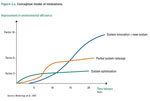

Sprachen:


Circularity must be conceived at the global level but adapted and implemented at the local level. The circular economy starts at the beginning of a product's overall life cycle, since the production phase represents a global impact on the environment, the supply of resources but the consumption patterns and the generation of waste are local issues22
The UNEP Panel assessment on “decoupling” identified the priority environmental impacts that interact in turn to lead to impacts on ecosystem health, human health and natural resource depletion. It identified the economic activities most associated with the resource and emissions pressures causing these environmental problems23. And in its conclusions (pg 11), the UNEP Panel’s clearly shows that “absolute decoupling” is possible. Technologies are available, as are examples of successful policies, price signals and incentives
Of course, innovation and investments are also indispensable and the Panel has identified areas for further research in this field. Its upcoming report, Decoupling in Practice, describes successful examples of decoupling technologies and policies that can be used to achieve it and, an emerging work stream on innovation will identify and quantify the potential role of innovations in the global decoupling process.
For the Factor 5 report, innovation in these areas is one of the keys and will need to take the form of a learning economy, where information is shared, rather than one knowledge economy, where information is patented and protected.
Some of the ways EU foresees to help to innovate globally for a circular economy are better and more ecological product design and production processes, direct economic incentives for producers to make products that can easily be reused or recycled, and supporting innovative industrial processes.
Among the initiatives of the EU program26:
22 Factor 5: Transforming the Global Economy through 80% Improvements in Resource Productivity by Ernst von Weizsäcker et al (2009/2010). www.clubofrome.org/report/factor-five/![]()
23 The IRP report on Priority Products and Materials identified the economic activities causing the highest environmental impact from several entry points: production sectors, consumption categories and materials categories. In the first priority list lie vehicle manufacturing, iron/crude steel production, livestock farming and non-metal extraction ; in the second priority list are found meat processing, concrete products, milk processing, other foodstuff, industry chemistry cement/lime/gypsum and paper industry. Responsible resource management for a sustainable world: findings by the International Resource Panel: Report of the Executive Director: UNEP/GC.27/INF/13, page 3
http://drustage.unep.org/about/cpr/information-documents-gc-27![]()
26 On his side, the European Environment Bureau developed different scenarios for future waste and resources targets Indicators and waste policy scenarios to deliver a resource efficient and sustainable Europe.
www.eeb.org/EEB/?LinkServID=4E9BB68D-5056-B741-DBCCE36ABD15F02F![]()

This summary is free and ad-free, as is all of our content. You can help us remain free and independant as well as to develop new ways to communicate science by becoming a Patron!